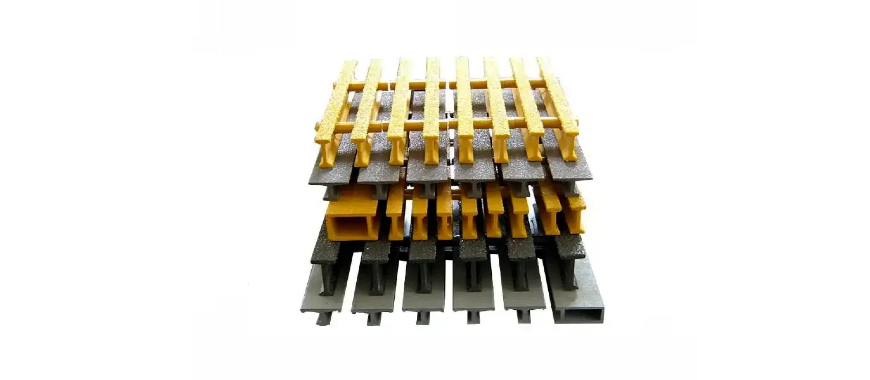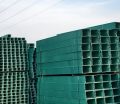
Grating fabrication is a crucial process in the manufacturing of durable and versatile grating products used in various industries. This process involves the creation of metal gratings through techniques such as welding, pressing, and locking, ensuring they meet specific project requirements. Especially in the production of phenolic grating, the fabrication process must account for its unique fire-resistant properties and ability to withstand harsh environmental conditions. The importance of grating fabrication extends across multiple sectors, including construction, oil and gas, and wastewater management. High-quality grating products provide essential safety features, such as slip resistance and proper drainage, while also supporting heavy loads in walkways and platforms. By understanding the principles of grating fabrication, businesses can make informed decisions about materials and methods, ultimately enhancing safety and efficiency in their operations.
Types of Grating Fabrication
Grating fabrication encompasses various types of materials and designs, each tailored for specific applications and environments. Understanding these types can help businesses select the right grating solutions for their needs.
Steel Grating Fabrication
Steel grating fabrication is one of the most widely used methods in the industry. It involves creating strong and durable grating products from steel, suitable for demanding applications.
Description and applications of steel grating: Steel grating is characterized by its load-bearing capabilities and resistance to impact. It is commonly used in walkways, platforms, drainage systems, and industrial flooring.
Benefits of using steel for grating:
High load-bearing capacity: Steel can support heavy equipment and foot traffic without deforming.
Durability: Steel grating withstands harsh environmental conditions, ensuring longevity.
Versatility: It can be customized for various applications, from light-duty to heavy-duty usage.
Bar Grating Fabrication
Bar grating fabrication focuses on the production of grates made from parallel bars, which provide excellent support and drainage.
Definition and features of bar grating: Bar grating consists of bearing bars and cross bars, which can be made from various materials. The spacing between these bars allows for light, air, and liquids to pass through while maintaining structural integrity.
Common applications and advantages:
Applications: Used in industrial floors, platforms, and stair treads.
Advantages:
Slip resistance: The design offers enhanced grip, reducing the risk of slips and falls.
Easy installation: Bar grating can be quickly assembled and fitted into existing structures.
Metal Grating Fabrication
Metal grating fabrication can involve various metals, each with distinct properties and applications.
Overview of different metals used in fabrication: Common metals used in grating fabrication include steel, aluminum, and stainless steel, each offering unique benefits based on the intended use.
Comparison of materials:
| Metal Type | Advantages | Common Applications |
|---|---|---|
| Steel | Strong, cost-effective | Industrial walkways, safety barriers |
| Aluminum | Lightweight, corrosion-resistant | Platforms, overhead grating |
| Stainless Steel | Highly durable, hygienic | Food processing, chemical industries |
Each type of grating fabrication has its specific applications and advantages, making it essential for businesses to choose the right material for their operational needs. By understanding these options, companies can ensure they select the most suitable grating solutions that enhance safety and efficiency in their projects.
Grating Fabrication Techniques
Grating fabrication involves several key techniques that are critical to producing high-quality grating products. Each method serves specific purposes and contributes to the overall functionality and durability of the grating.
Overview of Fabrication Methods
There are three primary methods used in grating fabrication: welding, pressing, and locking.
Welding: This method involves joining metal components using heat to create a strong, permanent bond. Welding is particularly effective for steel grating fabrication, where high strength and durability are required. The welded joints provide a robust structure capable of supporting heavy loads.
Pressing: Pressing uses hydraulic pressure to fuse components together. This method is often employed in the production of press-locked grating, where the cross bars are locked into the bearing bars without the need for additional fasteners. This results in a smooth surface and enhanced structural integrity.
Locking: Locking techniques, such as swage locking, involve inserting cross bars into pre-punched holes in the bearing bars. These bars are then mechanically secured to ensure stability. This method is popular for creating aesthetically pleasing grating with a sleek appearance.
Importance of Precision in Grating Span Direction
Precision is vital in grating fabrication, particularly concerning the span direction of the grating. The span direction refers to the distance between the bearing bars, which influences the load capacity and structural integrity of the grating.
Benefits of precision in span direction:
Load Distribution: Proper spacing ensures that loads are evenly distributed, reducing the risk of failure.
Safety: Accurate measurements minimize the chance of structural issues, enhancing the safety of walkways and platforms.
Compatibility: Precision allows for seamless integration with existing structures, ensuring that the grating fits correctly without gaps.
Considerations for Grating Opening Size
The size of the openings in the grating is another critical aspect of the fabrication process.
Key considerations for opening size:
Drainage: Larger openings allow for better water drainage, which is essential in environments prone to spills or rain.
Foot Traffic: The size of the openings should also consider foot traffic; smaller openings can provide better slip resistance while larger ones may be necessary for specific applications.
Safety Standards: Adhering to industry safety standards regarding opening sizes is crucial to prevent accidents and ensure compliance with regulations.
Understanding these grating fabrication techniques is essential for producing durable and effective grating solutions. By carefully considering the methods, span direction, and opening sizes, manufacturers can deliver high-quality products that meet the specific needs of their clients.
High-Quality Aluminum Expanded Metal Grating for Industrial Use
Innovative Approaches in Grating Fabrication and Custom Grating Solutions
Custom grating fabrication allows businesses to create tailored grating products that meet specific operational requirements and project specifications. This approach offers numerous advantages, making it an essential option for various industries.
Benefits of Custom Grating Fabrication
Investing in custom grating fabrication provides several key benefits that can enhance the functionality and efficiency of grating solutions:
Tailored Designs: Custom fabrication allows for designs that fit unique spaces and applications, ensuring optimal performance.
Material Selection: Businesses can choose from a variety of materials, including steel, aluminum, or stainless steel, based on their specific needs and environmental conditions.
Enhanced Safety Features: Custom solutions can incorporate specific safety features, such as slip-resistant surfaces or drainage openings, improving workplace safety.
Cost-Effectiveness: By optimizing the grating design for specific applications, companies can reduce waste and avoid unnecessary expenses associated with standard products.
Examples of Removable Grating Details and Applications
Removable grating systems are a popular custom solution, particularly in settings that require access to underlying structures or utilities.
Applications:
Maintenance Access: Removable grating allows for easy access to plumbing, electrical systems, and other infrastructure, facilitating routine maintenance and inspections.
Event Spaces: In venues that host large gatherings or exhibitions, removable grating can be used for temporary flooring that supports heavy foot traffic while allowing for quick removal when necessary.
Safety Grating: Custom removable grating can be designed to meet specific safety standards, making it suitable for industrial applications where regular access is required.
How to Choose the Right Grating for Specific Needs
Selecting the right grating solution involves several considerations that align with the intended application and environmental conditions.
Assessing Load Requirements: Determine the weight and type of loads the grating will need to support. This will help in selecting the appropriate material and design.
Environmental Factors: Consider exposure to elements such as moisture, chemicals, or heavy traffic, which can influence material choice and design specifications.
Consulting Experts: Engaging with grating fabrication professionals can provide insights into the best solutions for specific projects, ensuring that the selected grating meets all necessary requirements.
By exploring custom grating fabrication solutions, businesses can enhance their operations, improve safety, and ensure compliance with industry standards. This tailored approach to grating design not only meets specific needs but also maximizes efficiency and functionality across various applications.
Understanding Grating Surface: Key Role in Optics Applications
Finding Grating Fabrication Services
Finding reliable grating fabrication services is essential for ensuring high-quality products that meet specific project requirements. Whether you’re a contractor, engineer, or business owner, knowing how to locate and evaluate these services can greatly impact the success of your projects.
How to Locate Grating Fabrication Near Me
When searching for grating fabrication services in your area, consider the following methods:
Online Searches: Utilize search engines with keywords such as “grating fabrication near me” to find local suppliers and manufacturers. Including your location can help narrow down the options.
Industry Directories: Websites that specialize in industrial services often have listings for grating fabrication companies, complete with contact details and reviews.
Networking: Engaging with industry peers through networking events, trade shows, or online forums can provide recommendations for reputable fabricators in your area.
Evaluating Service Providers for Quality and Reliability
Once you’ve identified potential grating fabrication services, evaluating their quality and reliability is crucial:
Experience and Expertise: Look for companies with a proven track record in grating fabrication. Experienced providers are more likely to understand the nuances of different materials and fabrication methods.
Portfolio of Work: Review their past projects and case studies to gauge their capabilities. A diverse portfolio demonstrates their ability to handle various applications and custom requests.
Customer Reviews and Testimonials: Seek feedback from previous clients to assess their satisfaction with the services provided. Positive reviews can indicate a company’s commitment to quality and customer service.
Certifications and Standards: Check if the service provider adheres to industry standards and holds relevant certifications, which can enhance their credibility.
Importance of Local Suppliers in the Fabrication Process
Choosing local suppliers for grating fabrication offers several significant advantages:
Faster Turnaround Times: Proximity often leads to quicker communication and shorter lead times for fabrication and delivery, ensuring that your projects stay on schedule.
Easier Communication: Working with local suppliers facilitates better collaboration and clearer communication, making it easier to address any questions or adjustments during the fabrication process.
Support for Local Economy: By opting for local fabricators, you contribute to the growth of your community and support local jobs, which can have a positive impact on the overall economy.
Finding grating fabrication services involves researching local options, evaluating potential providers for quality and reliability, and recognizing the benefits of choosing local suppliers. By taking these steps, businesses can ensure they receive high-quality grating products that meet their specific needs, ultimately enhancing the success of their projects.
Mild Steel Grating: Best Sizes for Various Projects
Resources for Grating Fabrication
Access to comprehensive resources is essential for understanding grating fabrication processes and ensuring the production of high-quality grating products. These resources can guide manufacturers, contractors, and engineers in selecting materials, adhering to standards, and implementing best practices.
Available Guides for Grating Fabrication Processes
Several guides are available that detail the steps involved in grating fabrication. These resources often cover:
Fabrication Techniques: Detailed descriptions of various fabrication methods, such as welding, pressing, and locking, along with their applications.
Material Selection: Guidance on choosing the right materials based on project requirements, environmental conditions, and load-bearing capacities.
Installation Instructions: Best practices for installing grating systems to ensure safety and functionality, including tips for maintaining proper spacing and alignment.
These guides can be found in industry publications, online platforms, and through manufacturers’ websites, providing valuable information for anyone involved in grating fabrication.
Industry Standards and Best Practices
Adhering to industry standards is crucial in grating fabrication to ensure safety, performance, and quality. Key standards include:
ANSI/NAAMM Standards: The National Association of Architectural Metal Manufacturers (NAAMM) provides guidelines for the design, fabrication, and installation of metal grating, ensuring compliance with safety regulations.
ASTM Standards: The American Society for Testing and Materials (ASTM) sets forth specifications for various materials used in grating fabrication, ensuring consistency and quality across products.
Best Practices: These encompass recommendations for handling, storing, and maintaining grating products to enhance their longevity and performance.
Familiarizing yourself with these standards and practices is essential for producing reliable grating solutions.
Links to Additional Resources for Further Reading
For those looking to deepen their knowledge of grating fabrication, several online resources can provide further insights:
Industry Websites: Websites like the NAAMM and ASTM offer resources, technical papers, and certification information that can be invaluable for professionals in the field.
Technical Journals: Publications focused on engineering and manufacturing often feature articles on advancements in grating fabrication, innovative materials, and case studies.
Webinars and Training: Many organizations offer online seminars and training programs that cover various aspects of grating fabrication, providing an interactive way to learn from experts.
By leveraging these resources, professionals can enhance their understanding of grating fabrication, ensure compliance with industry standards, and implement best practices that contribute to the successful execution of their projects.
FAQs about Grating Fabrication
Grating in manufacturing refers to a series of parallel bars or elements that create a strong, durable surface used in various applications, such as flooring, walkways, platforms, and safety barriers. It is commonly made from metals like steel, aluminum, or stainless steel and is designed to allow for drainage while providing structural support. Grating is utilized across multiple industries, including construction, oil and gas, and wastewater management, due to its ability to withstand heavy loads and harsh environmental conditions. The design of grating ensures safety and accessibility while offering slip resistance. Custom grating fabrication allows manufacturers to tailor the dimensions, material, and features to meet specific project requirements, making it a versatile solution for many industrial needs.
Welding grating involves joining the bearing bars and cross bars to create a robust structure capable of supporting various loads. The process typically starts with positioning the bars in the desired configuration, ensuring proper spacing and alignment. Once in place, a welding machine applies heat to the contact points, melting the metal and forming a strong bond as it cools. Common welding techniques include resistance welding, where electrical currents create heat at the junctions, and TIG (Tungsten Inert Gas) welding, known for its precision. Proper welding is crucial to ensure the structural integrity of the grating, as it affects load-bearing capacity and durability. Post-welding inspections are often performed to check for any defects, ensuring that the final product meets industry standards for safety and performance.
The designation “19 W/4” in grating terminology provides specific information about the grating’s design and dimensions. The “19” indicates the spacing between the bearing bars in sixteenths of an inch, meaning the bars are spaced 1.1875 inches apart. The “W” stands for welded, signifying that the grating is manufactured using welded construction, which enhances its strength and stability. The “/4” refers to the spacing of the cross bars, indicating that they are placed 4 inches apart. This coding system helps engineers and contractors understand the specifications of the grating, making it easier to select the right product for a particular application, ensuring it meets the necessary load requirements and safety standards.
Various types of steel are used for grating fabrication, with the most common being carbon steel, stainless steel, and galvanized steel. Carbon steel is widely utilized due to its strength and cost-effectiveness, making it suitable for heavy-duty applications in industrial environments. Stainless steel is chosen for applications requiring corrosion resistance, particularly in environments exposed to moisture or chemicals, such as food processing and chemical manufacturing. Galvanized steel, which is coated with a layer of zinc, offers excellent corrosion protection and is often used in outdoor settings. Each type of steel has specific characteristics that make it suitable for different applications, so selecting the right material based on environmental conditions and load requirements is essential for ensuring the longevity and safety of the grating system.

As the editor of GangLong Fiberglass, I have years of experience and in-depth research, focusing on cable tray products, fiberglass solutions, and grille systems. I incorporate years of industry insights and practical experience into every content, committed to promoting the progress of the industry. At GangLong Fiberglass, my commitment is reflected in every product, from innovative cable trays to durable fiberglass solutions and sturdy grille systems. As an authoritative voice in the industry, my goal is to provide valuable information to professionals and businesses and promote forward-looking solutions.


